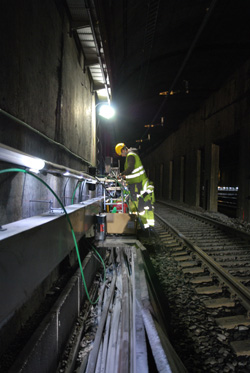Norwegian towns and cities, and many state agencies, had trouble finding qualified geologists and engineers just a year ago, and couldn’t compete with the high salaries offered by oil and offshore companies. Sudden cutbacks in Norway’s biggest industy, however, have provided sorely needed talent for the public sector, and jobs for laid-off experts.

“There’s a completely different and bigger wave of applicants now,” Bjørn Rosseland, a division chief within Oslo’s water and sewage department, told newspaper Dagens Næringsliv (DN) this week. “Many are highly qualified. I would estimate that around 80 percent of applicants have a residential address in ‘oil country’ along the West Coast.”
As unemployment continues to rise in Norway, to 4.8 percent based on the latest numbers from state statistics bureau SSB (Statistics Norway), at least some of those losing jobs in the oil and offshore industry are finding new jobs at non-oil-related companies or in the public sector. For Rosseland, the sudden availablity of geologists is a relief at a time when the Norwegian capital needs to rehabilitate its water and sewage system and plan for growth.
“We need geologists to maintain security and the population’s access to fresh water,” Rosseland told DN. With lengthy tunnels running under the city, large reservoirs and sewage treatment plants, “we need people who can evaluate bedrock and eventual risks.” He thought the city offered a good salary, at NOK 750,000 (USD 90,000) a year plus benefits, pension and a certain amount of job security, but it wasn’t enough last year to attract strong applicants. Now it is, and Rosseland said the city can finally proceed with badly needed projects. One vacant position in Oslo’s water and sewage department attracted 64 applicants, most of them highly qualified for the job.
The water and sewage department in Stavanger, Norway’s oil capital that’s been struggling since oil prices fell, is also now attracting top talent from the oil business while other geologists and engineers have been finding work at the state highway department (Statens vegvesen) and other public sector entities at the state and local level that are planning needed infrastructure improvements. The Norwegian government is investing in roads, rail and other transport projects, while towns and cities have major plans as well.

“Our advice for laid off members is that they swap branches,” said Tore Westhrin of Tekna, the labour organization for civil engineers and others with advanced technical degrees such as geologists. “Maybe also their residence, even though that can be tough for many.”
Some are being forced to do so. If they seek unemployment benefits from state welfare agency NAV, and suitable jobs are available outside their home districts, NAV is now cutting off benefits if the jobs aren’t accepted. NAV has been faced with record high payouts of benefits recently, because so many of those laid off had high salaries and can claim the highest level of unemployment compensation.
Many land new jobs fairly quickly, though. “Both our petroleum engineers and geologists have a lot of knowledge,” Westhrin if Tekna told DN. “Our impression is that they can also be attractive for other branches than the oil business, like the construction industry for example.”
Around 1,000 of Tekna’s roughly 70,000 members in Norway are now unemployed. Westhrin said that many of those laid off, however, generally do well at finding other jobs.
The situation remains serious for those still losing their jobs. According to SSB, around 134,000 people are now out of work in Norway, an increase of 47,000 in the past two years. That prompted opposition politicians from the Labour and Center parties to harshly criticize the Conservatives-led government on the floor of Parliament on Wednesday, for failing to do enough to tackle unemployment.
“This is much more serious than what the government predicted in its state budget for this year,” claimed Marianne Marthinsen, finance policy spokesperson for Labour. She and party colleagues accused the government of underestimating unemployment and the economic “crisis” in Norway that’s resulted from the oil price dive.
“We have always said that there is considerable uncertainty tied to developments in the labour market,” responded Finance Minister Siv Jensen. She acknowledged that the government predicted unemployment of 4.5 percent, instead of the 4.8 percent set by SSB, but stressed it has proposed several “long-term measures” to help create new jobs, and not just in the public sector.
“I think everyone understands that this takes time,” Jensen said. “There is growth in some areas of the Norwegian economy and decline in others. It makes the situation demanding.”
newsinenglish.no/Nina Berglund

